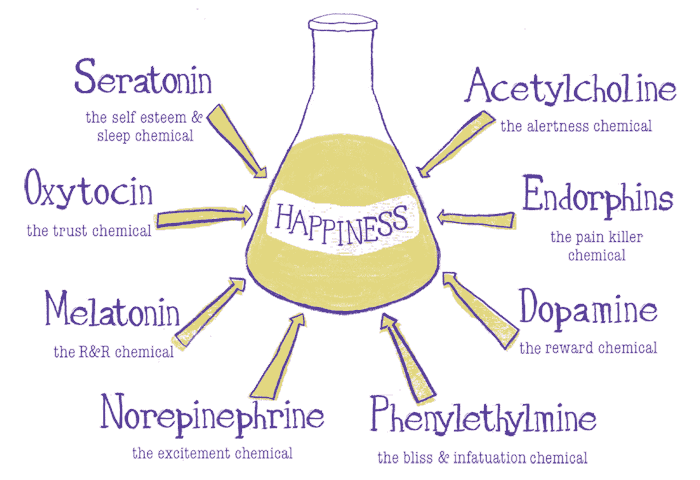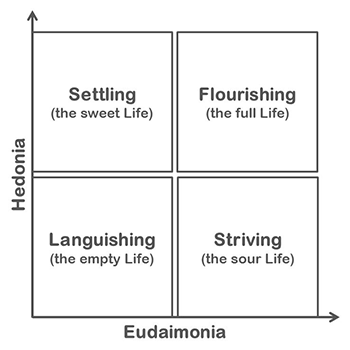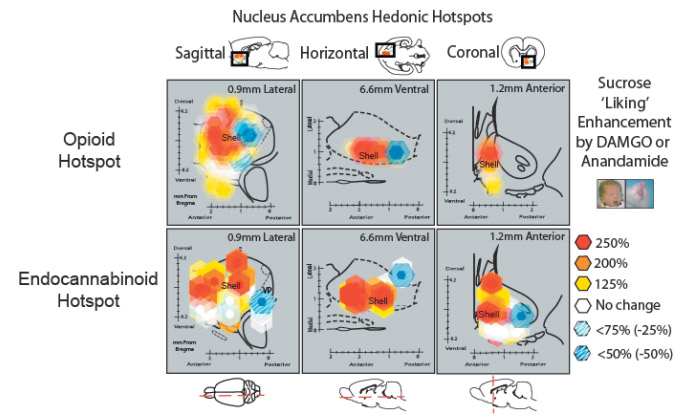By Tanja Bagar

Dr. Tanja Bagar is a microbiologist with a PhD in Biomedicine. She has gained extensive research experience in biotechnology, molecular biology and cell signaling in laboratories in Slovenia, Germany and the UK. Her focus has mainly been on the endocannabinoid system and active substances from cannabis/hemp. Her work led to the formation of the International Institute for Cannabinoids (ICANNA), where she is the CEO and chairman of the Expert Council. She is also the deputy director and head of R&D in an environmental company. She is active in the academic sphere as well. She lectures on microbiology and is the dean of the master’s program of Ecoremediations at the Faculty Alma Mater Europaea.
One of the hallmarks of the human race is our drive for happiness. Throughout evolution, we have been pursuing better locations, better food, better living conditions…a better life. A state where we feel good about ourselves, our life and our environment, a state of harmony and bliss. But if we look around us today, we see that this pursuit has not brought us much closer to that state, but paradoxically further away. The statistics are very disturbing; the incidences of depression, anxiety, mood disorders, psychosomatic diseases are higher than ever before and still increasing. So where did we go wrong? Could cannabinoids be the missing key to achieving this state?
During evolution, we have faced many challenges, mostly a lack of food and shelter and the danger posed by predators. In modern society, the challenges are very different; food and shelter are abundant, but nonetheless we are under increasing stress, exposed to ever more toxins in our food, drinking water and air, pressure to be the best workers, parents, spouses… The defence mechanisms of our bodies have never faced so many challenges as they do today. And how is our body equipped to deal with these challenges? In biology classes, we learned about the physical barriers, like skin and mucosa to defend us, the immune system to guard us from pathogens, the hormonal system to communicate and regulate biological functions. But the majority of us have not been taught that we have another protective system that regulates all other physiological functions: the endocannabinoid system. It is composed of endocannabinoids, cannabinoid receptors, and enzymes that make and degrade endocannabinoids.
The role of the endocannabinoid system (ECS) in human physiology is well documented and scientifically supported. There is a large body of evidence that endocannabinoids regulate mood, emotion, motivation, memory, pleasure perception, appetite, metabolism and much more. The connection between cannabinoids and emotional states has long been empirically and scientifically established. Even the first active ingredient discovered from the cannabis plant (Cannabis sativa), delta9-tetrahydrocannabinol (delta9-THC), has been known to produce euphoria and an enhancement of sensory perceptions.

Since the discovery of cannabinoid receptors, their abundance in the brain has puzzled scientists. In certain regions of the brain, the neurons have more cannabinoid receptors than any other type of receptor. It seemed unusual that our cells would be so finely tuned to these molecules. Originally, cannabinoids were regarded as relatively rare, being found primarily in just one genus of the plant kingdom, Cannabis. The discovery of arachidonylethanolamide (AEA), a THC analog, later named anandamide, provided the answer. The reason our cells have so many cannabinoid receptors is that we make our own cannabinoids, and they are vital to our overall well-being.
Research into endocannabinoids provided insight into a brand new class of signaling molecules that seem to have a very broad spectrum of actions. They affect practically every cell type, tissue, and organ. The condition of our ECS also determines how we feel. Until this discovery, serotonin and endorphins were thought to be the “happy molecules”, known for their role in regulating and affecting emotional states. But the discovery of endocannabinoids revealed a new biochemical pathway to happiness. The name of the endocannabinoid anandamide itself (ananda is the Sanskrit word for “joy, bliss, happiness”) suggests its involvement in mood. Now research has also shown a strong connection between the serotonergic and endocannabinoid systems, pointing to a connection between the release of endocannabinoids and serotonin (Best and Regehr, 2008).
The connection between depression, anxiety, mood disorders, emotional states and cannabinoids is an established fact, and a lot of research is currently focusing on it. There are two aspects of positive emotional states, one temporary (hedonia) and one static (eudaimonia) (Berridge at al, 2011). While hedonia is largely influenced by circumstances and the current situation we find ourselves in, eudaimonia is a measure of the level of our overall satisfaction with life. Our endocannabinoids have been shown to be involved in both aspects (as are phytocannabinoids). On one hand, the proper balance of cannabinoids increases our sensitivity to positive stimuli, and on the other, these molecules act like buffers that dampen negative emotions (Matsunaga et al, 2014). This increases the good influences and reduces the bad influences from our surroundings.

The genes that code for the cannabinoid receptors also play an important role. The proposal that our genes determine our future holds true to a certain degree in this case also. There are small variations (polymorphisms) in the genes that code for the CB1 receptor which make huge differences. People with a specific genetic code for the CB1 receptor seem to be much happier in general and respond significantly better to positive stimuli. A small difference goes a long way, but it's not just the receptors that are important. The levels of cannabinoids also affect our emotional states and our ability to deal with stress to a large extent.
Cannabinoids play an important role in stress responses. Endocannabinoids are the molecules that are released in our bodies in response to diverse stress stimuli, such as injury, temperature change, pathogens, toxins, emotional stress, etc. They have a strong protective role, functioning as guardian molecules, protecting us from the physiological consequences of stress. But if the stress persists over a longer period of time, our defence mechanisms become downregulated, i.e. weakened, leading to depression-like symptoms. Endocannabinoids (as well as phytocannabinoids) influence the biochemical machinery involved in how we process stress and emotions. When we are under stress, but also in response to positive stimuli, certain regions of the brain become active, the same parts of the brain that have the most cannabinoid receptors. They are called hedonic brain hotspots (Wang et al, 2015). This proves a direct anatomical correlation between happiness and cannabinoids, as the brain regions sensitive to positive stimuli and stress have the highest density of cannabinoid receptors and are therefore most sensitive to endo- and phytocannabinoids.
But it's not only the genes and concentration of cannabinoids that are important. Even the foods we choose to eat and the supplements (probiotics, omega 3 fatty acids) we take affect the ECS and hence our happiness. Some foods such as extra virgin olive oil contain phenolic compounds which may encourage the expression of cannabinoid receptors (Di Francesco et al, 2015). It is interesting that research has shown that even the atmosphere (ambient, music) of meals makes a difference to our ECS (Schrieks et al, 2015). Massage and aerobic exercise have also been shown to increase the levels of endocannabinoids. Even acupuncture and fasting modulate the ECS (McPartland et al, 2014).
So how well we deal with stress and how well we respond to positive things in life overall determine how good we feel about ourselves and our life. Our ability to deal with stress and respond to positive stimuli is directly correlated to the state of our ECS. And this state is highly individual (levels of cannabinoids and number of receptors), offering an explanation of why the same strains of cannabis or concentrations of cannabinoids can have a very different effect on the mood of different people. After phytocannabinoids enter our system, they affect the individual ECS and can have a very different effect on people with many vs few cannabinoid receptors, and people with high vs low levels of endocannabinoids.

It becomes even more complicated when we consider that our definitions of positive stimuli vary greatly. Some people enjoy a heavy metal concert, and others a classical piano concert. Some experience positive emotions when thinking about climbing a snowy mountain peak, while others dive in tropical seas. The same situation can be perceived as positive by one person and as stressful by another, pointing to an even higher degree of individuality. The paths we choose in search of happiness are as individual as our ECS. How we look at our surroundings and how we feel about them determine our responses. But the underlying biochemistry of happiness remains the same, with endocannabinoids and the ECS playing a pivotal role in the long-term well-being of all individuals. In this case we can say for sure that ignorance is no longer bliss.
Caring for and feeding our ECS are of vital importance. It is important that we recognize early on the signs that we are exhausting our system and challenging our homeostasis. This can prevent a failure of our ECS and mood disorders and the diseases that can follow. We know that the modern lifestyle is challenging our defence mechanisms every day, so reaching for natural phytocannabinoids that protect and nurture our defence mechanisms seems a logical step.
Given that thousands of citizens worldwide are still being arrested every year just for using a herb containing cannabinoids to feel better or happier, we should ask ourselves if ignoring the potential of these molecules is not a greater crime. Our basic human right to be healthy and happy is in serious danger. With the overwhelming worldwide evidence of where prohibition has brought us, we come to the conclusion that: Bliss is not the problem ~ ignorance is.
References:
Berridge KC, Kringelbach ML. Building a neuroscience of pleasure and well-being. Psychol Well Being. 2011 Oct 24;1(1):1-3.
Best AR, Regehr WG. Serotonin evokes endocannabinoid release and retrogradely suppresses excitatory synapses. J Neurosci. 2008 Jun 18;28(25):6508-15.
Di Francesco A, Falconi A, Di Germanio C, Micioni Di Bonaventura MV, Costa A, Caramuta S, Del Carlo M, Compagnone D, Dainese E, Cifani C, Maccarrone M, D'Addario C. 2015. Extravirgin olive oil up-regulates CB1 rumor suppressor gene in human colon cancer cells and in rat colon via epigenetic mechanisms. Journal of Nutritional Biochemistry. 26(3): 250-258.
Matsunaga M1, Isowa T2, Yamakawa K3, Fukuyama S4, Shinoda J4, Yamada J4, Ohira H3. Genetic variations in the human cannabinoid receptor gene are associated with happiness. PLoS One. 2014 Apr 1;9(4).
McPartland JM, Guy GW, Di Marzo V. Care and feeding of the endocannabinoid system: a systematic review of potential clinical interventions that upregulate the endocannabinoid system. PLoS One. 2014 Mar 12;9(3).
Schrieks IC, Ripken D, Stafleu A, Witkamp RF, Hendriks HF. Effects of mood inductions by meal ambiance and moderate alcohol consumption on endocannabinoids and N-acylethanolamines in humans: a randomized crossover trial. PLoS One. 2015 May 11;10(5):e0126421.
Wang W, Sun D, Pan B, Roberts CJ, Sun X, Hillard CJ, Liu QS. Deficiency in endocannabinoid signaling in the nucleus accumbens induced by chronic unpredictable stress. Neuropsychopharmacology. 2010 Oct;35(11):2249-61.


